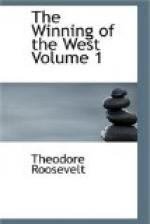24. The expression “too horrible to mention” is to be taken literally, not figuratively. It applies equally to the fate that has befallen every white man or woman who has fallen into the power of hostile plains Indians during the last ten or fifteen years. The nature of the wild Indian has not changed. Not one man in a hundred, and not a single woman, escapes torments which a civilized man cannot look another in the face and so much as speak of. Impalement on charred stakes, finger-nails split off backwards, finger-joints chewed off, eyes burned out—these tortures can be mentioned, but there are others equally normal and customary which cannot even be hinted at, especially when women are the victims.
25. For the particular incident see M’Ferrin’s “History of Methodism in Tennessee,” p. 145.
26. As was done to the father of Simon Girty. Any history of any Indian inroad will give examples such as I have mentioned above. See McAfee MSS., John P. Hale’s “Trans-Alleghany Pioneers,” De Haas’ “Indian Wars,” Wither’s “Border War,” etc. In one respect, however, the Indians east of the Mississippi were better than the tribes of the plains from whom our borders have suffered during the present century; their female captives were not invariably ravished by every member of the band capturing them, as has ever been the custom among the horse Indians. Still, they were often made the concubines of their captors.
27. The missionaries called themselves United Brethren; to outsiders they were known as Moravians. Loskiel, “History of the Mission of the United Brethren,” London, 1794. Heckewelder, “Narrative of the Mission of the United Brethren,” Phil., 1820.
CHAPTER V.
THE BACKWOODSMEN OF THE ALLEGHANIES. 1769-1774.
Along the western frontier of the colonies that were so soon to be the United States, among the foothills of the Alleghanies, on the slopes of the wooded mountains, and in the long trough-like valleys that lay between the ranges, dwelt a peculiar and characteristically American people.
These frontier folk, the people of the up-country, or back-country, who lived near and among the forest-clad mountains, far away from the long-settled districts of flat coast plain and sluggish tidal river, were known to themselves and to others as backwoodsmen. They all bore a strong likeness to one another in their habits of thought and ways of living, and differed markedly from the people of the older and more civilized communities to the eastward. The western border of our country was then formed by the great barrier-chains of the Alleghanies, which ran north and south from Pennsylvania through Maryland, Virginia, and the Carolinas,[1] the trend of the valleys being parallel to the sea-coast, and the mountains rising highest to the southward. It was difficult to cross the ranges from east to west, but it was both easy and natural to follow the valleys between. From Fort Pitt to the high hill-homes of the Cherokees this great tract of wooded and mountainous country possessed nearly the same features and characteristics, differing utterly in physical aspect from the alluvial plains bordering the ocean.




